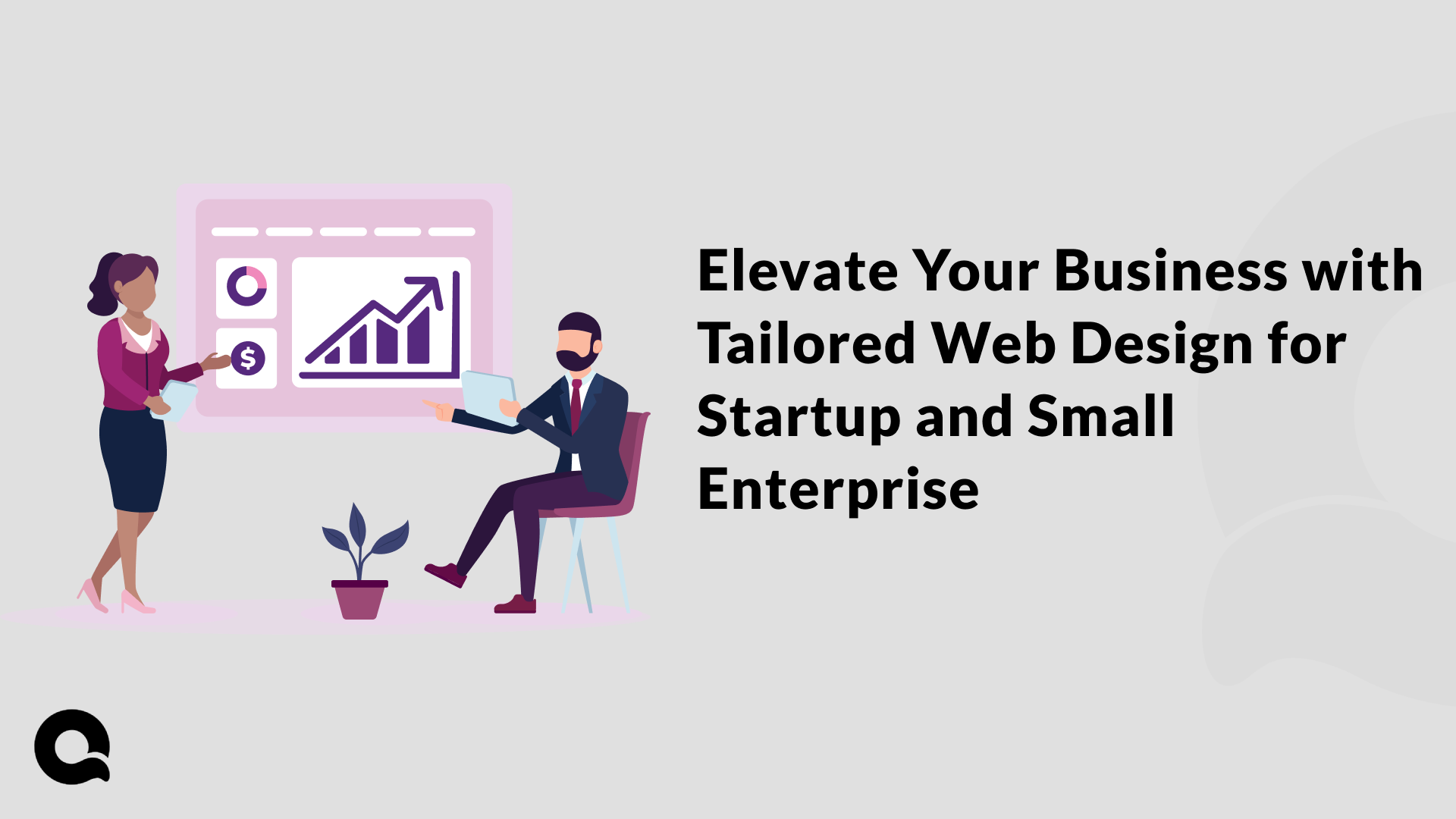
Introduction
In today’s ever-evolving digital landscape, the online presence of a business holds the power to determine its triumph or downfall. A meticulously crafted website is not just a mere choice anymore; it stands as an absolute necessity. For startups and small enterprises, an influential online identity isn’t just important; it’s the primary arena where they interact with potential customers. This article delves into the pivotal role of website design for businesses, with a particular focus on startups and small enterprises. It highlights how tailored website solutions can be the driving force behind their growth. Let’s explore the significance of {keywords} in crafting effective web designs that resonate both with audiences and search engines.
The Significance of Website Design for Businesses
In the vast expanse of the internet, your website serves as your digital storefront. It’s the initial impression that a prospective customer forms about your business. And, as the age-old saying goes, “First impressions are lasting.” A visually captivating and user-friendly website can capture the attention of visitors, creating trust and piquing curiosity. On the flip side, a poorly designed website can lead visitors to exit within seconds, leaving behind a negative imprint.
User experience (UX) is equally pivotal. A website that is easy to navigate, loads swiftly, and offers valuable information ensures a positive experience, enticing visitors to delve deeper. Neglecting UX can result in high bounce rates, missed opportunities, and a tarnished reputation.
Tailored Solutions: One Size Doesn’t Fit All
In a world that celebrates individuality, off-the-shelf solutions often fall short, especially in web design. Startups and small enterprises possess unique identities, audiences, and objectives. Generic templates cannot encapsulate their essence or effectively engage their target audience.
Understanding Your Business Needs
Before embarking on the journey of website design, it is crucial to understand your business’s objectives, values, and target audience. Your website should embody your brand, reflecting your identity and connecting with potential customers. Conduct thorough audience research to discern your unique selling points. This solid foundation will guide your design decisions.
Elements of Effective Website Design
- Visual Elements
- Color Palette and Branding: Harmonize your website’s color scheme with your brand’s, creating a consistent identity across all platforms.
- Typography Choices: Select legible and visually pleasing fonts that work seamlessly across various devices.
- Imagery and Graphics: Integrate high-quality visuals that align with your products or services, enhancing user engagement.
- Layout and Navigation
- Intuitive Navigation: Simplify user journeys with a clear navigation menu and logically organized content.
- Mobile Responsiveness: Optimize your website to ensure a seamless experience on all devices, regardless of screen size.
- Content Strategy
- Engaging and Informative Content: Craft compelling copy that educates and resonates with your audience, fostering engagement.
- Call-to-Actions (CTAs): Strategically position CTAs to guide visitors toward conversion actions, such as purchases or sign-ups.
Benefits of Custom Website Design for Startups and Small Enterprises
- Enhanced Brand Identity
- Building a Strong Brand Presence: Customized design cultivates a memorable and unique brand image.
- Standing Out from Competitors: Personalization sets you apart in a crowded marketplace.
- Improved User Experience
- Reducing Bounce Rates: Intuitive design maintains visitor interest, reducing quick exits.
- Increasing User Engagement: A positive UX encourages exploration and interaction, extending on-site time.
- Increased Conversions
- Optimizing CTAs: Strategic CTAs guide visitors toward desired actions, resulting in higher conversion rates.
- Building Trust and Credibility: Professional design fosters trust, leading to increased conversions.
- Scalability and Flexibility
- Designing for Growth: Custom design anticipates future expansion, enabling seamless evolution.
- Adapting to Changes: Implementing updates becomes effortless, allowing you to stay aligned with shifting market trends.
Case Studies: Real-Life Examples
Example 1: The Blossoming Artisan Bakery
Challenges:
A local artisan bakery aspired to expand its reach through online orders, but they faced a significant challenge. Their existing website lacked the visual appeal and user-friendliness needed to attract and retain customers in the competitive online bakery market.
Custom Design Strategy:
- Visual Transformation: The custom web design initiative commenced with a complete visual overhaul. It introduced inviting colors and integrated high-resolution images that showcased the bakery’s mouthwatering products. This transformation aimed to captivate visitors from the moment they landed on the website.
- Streamlined Ordering: To enhance the customer experience, the website was equipped with a streamlined ordering process. This feature simplified the selection and checkout process for customers, making it convenient and efficient.
- Brand Consistency: The website design maintained consistency with the bakery’s brand, ensuring that the online presence aligned seamlessly with its physical stores.
Results: The impact of the custom web design was remarkable:
- Within a mere three months, the bakery experienced a 30% surge in online orders, reflecting a substantial increase in customer engagement and conversion rates.
- The visually appealing website and improved user experience garnered positive feedback from customers, enhancing the bakery’s reputation and customer loyalty.
Example 2: The Innovative Tech Startup
Challenges: An innovative tech startup sought to establish its online presence as a leading authority in its niche. However, their existing website lacked the professional and user-friendly interface necessary to convey their expertise effectively and engage potential clients.
Custom Design Strategy:
- Sleek Aesthetics: The custom web design approach focused on sleek aesthetics that projected a sense of professionalism and innovation. This design aimed to immediately convey the startup’s commitment to cutting-edge technology.
- User-Focused Navigation: The revamped website placed a strong emphasis on user-focused navigation. It ensured that visitors could effortlessly explore the startup’s products, gaining insights into their value and relevance.
- Visual Simplicity: The design incorporated a visually clean and uncluttered layout, enhancing the user experience and enabling easy access to essential information.
Results: The impact of the custom web design was transformational:
- The startup witnessed a substantial 20% increase in website traffic within a short period.
- Notably, there was a 15% rise in product inquiries, reflecting the enhanced clarity and accessibility of product information.
- The website’s polished and professional appearance bolstered the startup’s credibility, positioning them as a trustworthy authority in their field.
Example 3: Online Fashion Boutique
A budding online fashion boutique aimed to establish itself as a go-to destination for fashion enthusiasts. Before opting for custom web design, their website had a generic look that failed to capture the essence of their unique fashion collections.
Custom Design Strategy:
- Aesthetic Customization: The design team revamped the website with a visually stunning and fashion-forward layout. They incorporated high-resolution images showcasing the boutique’s products from various angles, allowing visitors to appreciate the details.
- Brand Alignment: The website’s color scheme and typography were aligned with the boutique’s brand, reinforcing a consistent identity.
- User Experience Focus: To enhance user experience, they implemented a seamless product browsing and selection process, complete with filters for style, size, and color.
Results: Within three months of implementing custom web design, the online fashion boutique witnessed remarkable improvements:
- A 40% increase in website traffic.
- A 25% rise in the average session duration, indicating that visitors were spending more time exploring the collections.
- A notable 15% increase in online sales, reflecting the positive impact of the redesigned website on conversions.
Finding the Right Website Design Partner
To unlock the full potential of custom design, it’s imperative to partner with seasoned professionals who understand your unique needs. When selecting an agency or freelancer, carefully assess their portfolio, industry experience, and client feedback. Effective communication and a shared vision are the pillars of a successful collaboration.
Actionable Steps for Implementing Tailored Design
Implementing custom design involves:
- Clearly defining design requirements based on your business goals.
- Creating mood boards to effectively convey your design vision.
- Embracing an iterative design process, incorporating feedback to continually refine the design.
Conclusion
In the fast-paced digital arena, startups and small enterprises must leverage every advantage at their disposal. Custom website design isn’t a luxury but a strategic investment that elevates your brand, enhances user experience, and fuels conversions. By embracing {keywords}, businesses ensure modern, user-centric websites that are primed for growth. Remember, your website is more than virtual; it’s a powerful tool that shapes the trajectory of your business.
Ready to elevate your online presence? Hire Us to discuss how our tailored web design solutions can transform your brand and drive results. Your success story begins with a single click.
Frequently asked questions
Custom web design involves creating a website from scratch, tailored specifically to a business's unique needs, brand, and goals. It is highly personalized and offers more flexibility and creativity compared to template-based design, where websites are built using pre-made templates that may not be as unique or adaptable.
Custom web design is crucial for startups and small enterprises because it allows them to create a strong and memorable online presence that reflects their brand identity. It enables them to stand out in a competitive market, engage their target audience effectively, and provide a seamless user experience.
The key elements of effective website design highlighted in the article include visual elements such as color palette, typography choices, and imagery; layout and navigation that prioritize intuitive user experiences; and a content strategy that focuses on engaging and informative content and strategically placed call-to-actions (CTAs).
Custom web design can reduce bounce rates by ensuring that the website is user-friendly, loads quickly, and provides valuable information. When visitors have a positive experience and find the content engaging, they are more likely to stay on the website and explore further, reducing bounce rates.
To find the right website design partner, businesses should:
• Review the partner's portfolio to assess their previous work.
• Consider their industry experience and expertise.
• Seek feedback and testimonials from previous clients.
• Ensure effective communication and alignment with the partner's vision for the project.
The article suggests three actionable steps for implementing custom web design:
1. Clearly define design requirements based on your business goals.
2. Create mood boards to effectively convey your design vision.
3. Embrace an iterative design process, incorporating feedback to continually refine the design.
Custom web design is not just a one-time investment. It may require ongoing maintenance to keep the website up-to-date, secure, and aligned with changing business goals and industry trends. Regular updates and improvements are essential for long-term success.






